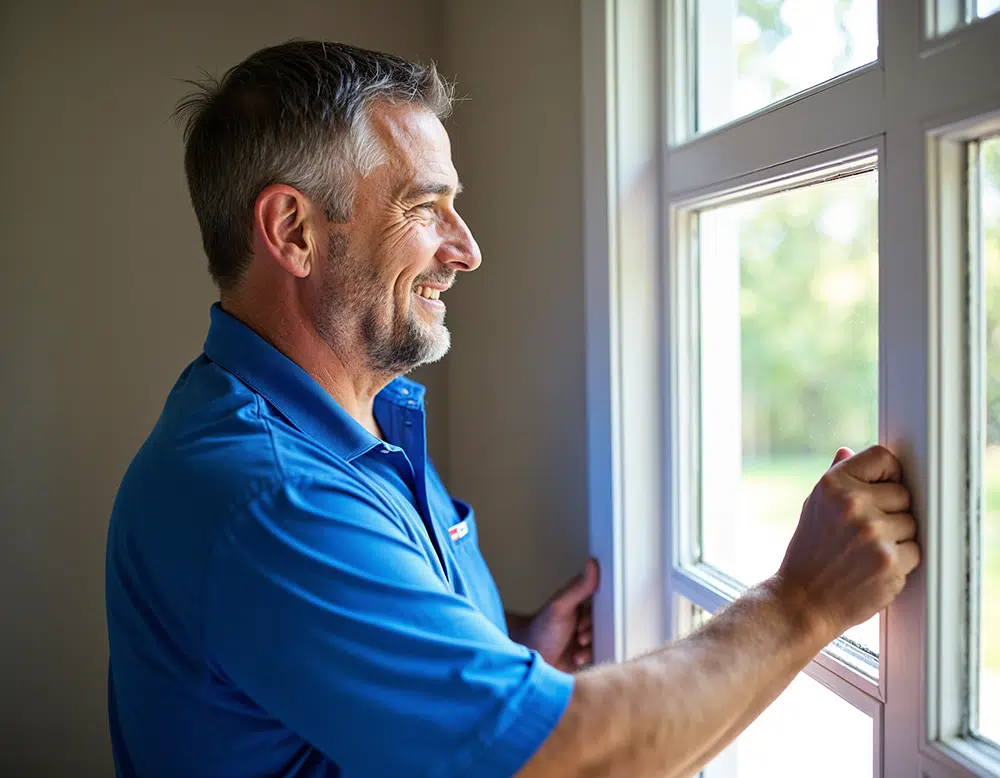Windows are a vital part of your home’s structure, they contribute to making your house look great, and keeping energy efficiency high. Unfortunately, various issues can occur over time that will negatively affect the look or insulation capability of your house. Understanding and addressing these common window problems promptly can help you prevent costly repairs and maintain a comfortable living environment.
How to Identify Common Window Issues
The only way to spot window problems early is through regular inspections. Watch out for the following signs:
- Condensation and Mold: If you notice excess moisture around your windows, it could lead to condensation on the glass and mold growth around your window. Heavy condensation on your windows often signals high humidity levels or broken seals, both of which can harm your indoor air quality and comfort.
- Difficulty Closing the Window: Struggling to close your windows? Broken windows can stem from warped frames or worn-out hardware, and lead to drafts and security risks.
- Excess Noise from Outside: Unusual levels of noise from outside might indicate poor insulation or gaps in your window frames, suggesting the need for better sealing or window replacement.
10 Common Window Problems
| Problem | Details | Impact | Prevent |
| Window Frame Damage | Cracks, warping, or rotting in frames. | Air leakage, water damage, structural failure. | Regular inspections, apply sealant, repair immediately. |
| Sash Windows Not Working Properly | Balance systems or locks fail, causing difficulty in operation. | Drafts, security risks. | Regular maintenance, lubricate moving parts. |
| Broken Seals | Moisture buildup between panes, fogging, condensation. | Reduced insulation, mold growth, aesthetic issues. | Inspect seals regularly, replace if necessary. |
| Poor Window Installation | Gaps between frame and wall, improper sealing. | Energy loss, discomfort, moisture intrusion. | Hire reputable contractors, ensure proper sealing. |
| Leaky Windows | Water entering through gaps or old seals. | Water damage, reduced energy efficiency. | Inspect regularly, maintain seals and caulking. |
| Broken Lock Systems | Locks fail, compromising security. | Security risks, drafts. | Check and replace locks, upgrade security. |
| Warping Wood Frames | Frames warp due to humidity or temperature changes. | Compromised security, drafts, further damage. | Seal and paint regularly, use dehumidifiers. |
| Cracked Glass Panes | Glass cracks due to impact or thermal stress. | Safety hazard, reduced insulation. | Replace cracked panes, use stronger glass. |
| Water Damage Around Windows | Signs of leaks or poor sealing, leading to mold and rot. | Significant repair costs, unhealthy environment. | Inspect regularly, address leaks immediately. |
| Drafty Windows | Poor seals or gaps allow air leakage. | Higher energy bills, discomfort. | Check and replace seals, add weatherstripping. |
Addressing these common window problems promptly can save you from more significant repairs down the line.
1. Window Frame Damage

Window frames, especially wood frames, are prone to damage over time due to weather exposure and general wear and tear. The wood windows are particularly susceptible to warping and rotting because of moisture absorption. Vinyl windows are more durable and require less maintenance as they do not warp, rot, or suffer from bug infestations.
Cracks, warping, or rotting can develop, leading to air leakage and water damage. If left unchecked, these issues can compromise the structural integrity of your windows and even affect your home’s overall stability.
Impact: Damaged frames can lead to increased energy bills as drafts enter your home, making your heating and cooling systems work harder and water intrusion through these cracks can cause rot in surrounding areas.
Prevention: Regularly inspect your window frames for signs of damage. If you notice any cracks or warping, address them immediately. For wooden frames, consider applying a protective sealant to prevent moisture infiltration.
2. Sash Windows Not Working Properly

Sash windows, known for their traditional look, can develop issues with their balance systems or locks over time. If these components fail, the windows may not close properly, leading to drafts and potential security risks.
Impact: Poorly functioning sash windows can compromise your home’s security, and drafts entering through improperly closed windows can increase your energy consumption, leading to higher utility bills.
Prevention: Regular maintenance of sash windows is essential, this includes lubricating moving parts, as needed, to keep them operating smoothly. Some questions you should answer as you inspect your sash windows: Is the balance system functioning as expected? Do the locks engage securely?
3. Broken Seals

The seal between double-pane and triple pane windows prevents moisture buildup between the panes. When seals break, condensation can form, leading to foggy windows and reduced visibility. Single pane windows are more susceptible to condensation and drafts due to their lack of insulation.
Impact: Broken seals reduce the insulating properties of your windows, leading to higher energy costs and potential mold growth within your walls. Foggy windows can detract from your home’s appearance and decrease the value of your property.
Prevention: Inspect your windows for signs of broken seals. If you notice condensation between the panes, it may be time to replace the seals or even the entire window, depending on the severity of the damage.
4. Poor Window Installation
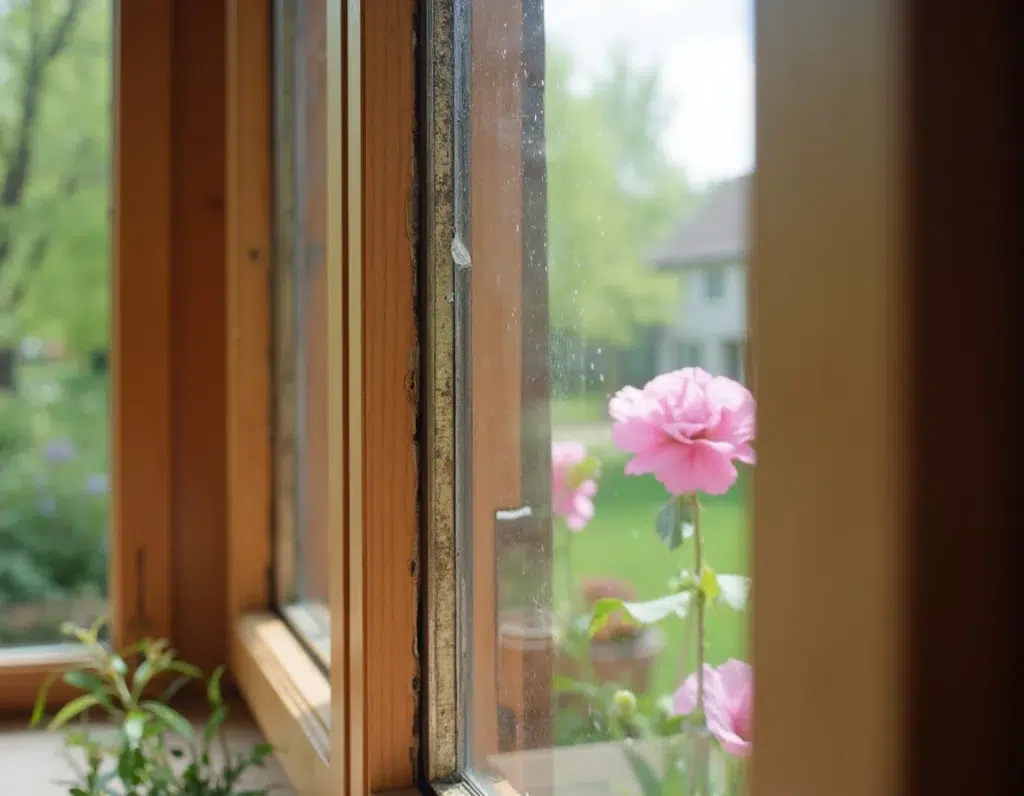
Even the best windows can underperform if they are not installed correctly. Gaps between the window frame and the wall can allow drafts to enter, impacting your home comfort.
Impact: Poor installation can lead to higher heating and cooling costs as your HVAC system needs to work harder to maintain a comfortable temperature. Over time, the gaps from a poor installation can allow moisture to seep in, leading to water damage and mold growth.
Prevention: Always hire a reputable and experienced contractor for window installation. Check that all gaps are properly sealed during the installation process, and ask about any warranties or guarantees on the workmanship.
5. Leaky Windows
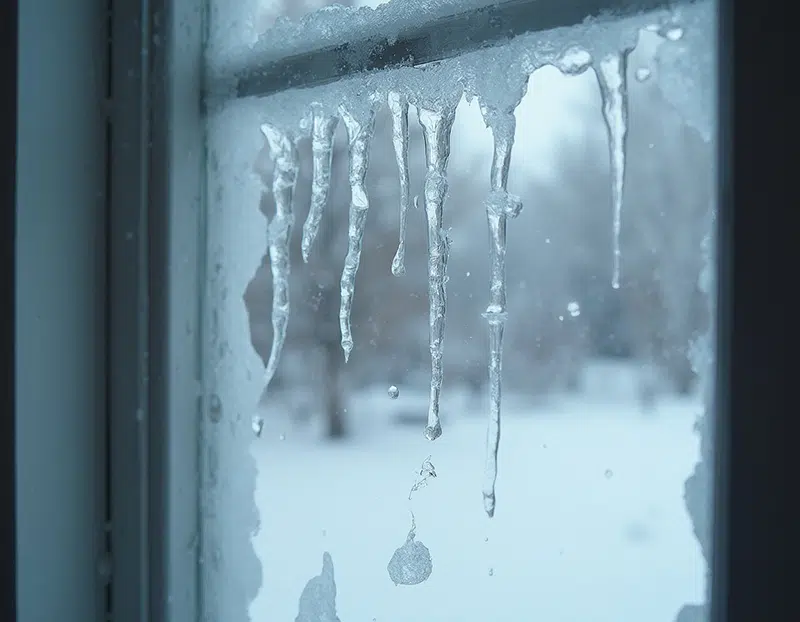
Older windows or those with inadequate waterproofing can develop leaks over time. Water entering through these leaks can cause significant damage to your home’s walls, floors, and insulation.
Impact: Leaky windows can lead to extensive water damage, requiring costly repairs. The leaks reduce your home’s thermal efficiency by allowing cold air to enter during winter and warm air during the summer.
Prevention: During rain or snow, inspect your windows for signs of leaks. See if all seals and caulking are intact and in good condition. If there’s any water intrusion, address it immediately to prevent further damage.
6. Broken Lock Systems
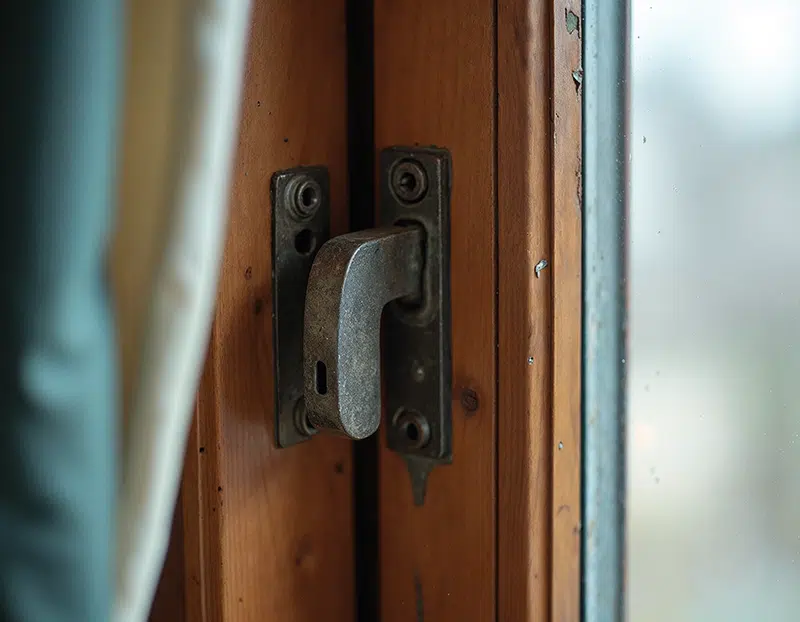
A broken window lock compromises security and allows drafts. Broken locks are more common in older wooden windows where the locking mechanisms can wear out or get damaged over time.
Impact: A broken lock system poses a significant security risk, as it allows easy access for burglars. Not only that, it can reduce the effectiveness of your windows in sealing out drafts.
Prevention: Regularly check the locks on all your windows. If they are difficult to operate or no longer function properly, replace them immediately. You may want to consider upgrading to modern lock systems that offer enhanced security features.
7. Warping Wood Frames
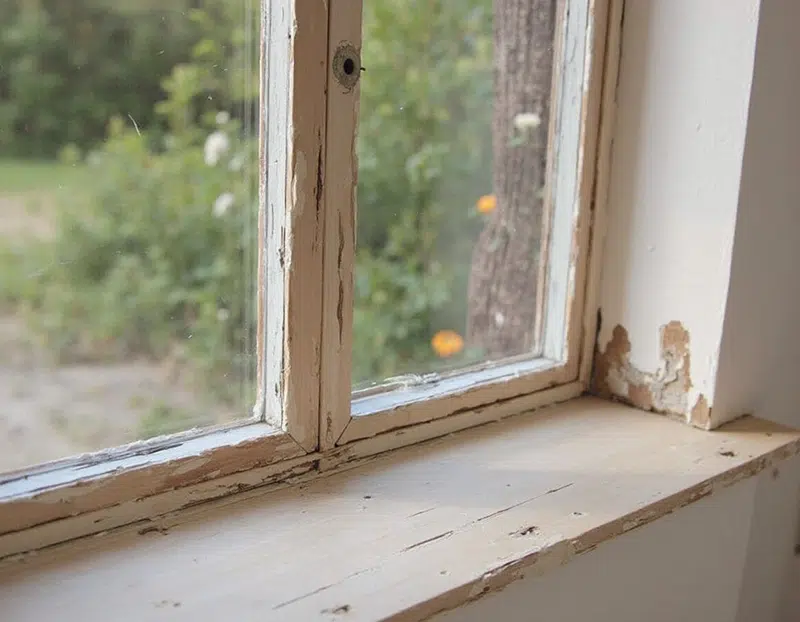
Wooden window frames are susceptible to warping due to changes in humidity and temperature. Warping causes the frame to twist or bend, making it difficult to open or close the window, and creates gaps that allow drafts and moisture to enter your home.
Impact: Warped frames compromise the security and energy efficiency of your windows. They can lead to rot and structural failure if not addressed properly.
Prevention: To prevent warping, protect your wooden frames from moisture by properly sealing and painting your frames regularly. If you have rooms with particularly high humidity, you should consider using dehumidifiers to reduce the risk of warping.
8. Cracked Glass Panes

Window panes can crack due to a variety of reasons, including accidental impacts, thermal stress, or aging. Cracked window panes reduce the aesthetic appeal of your windows and also pose a safety hazard.
Impact: Cracked glass lowers the integrity of the window, and increases the risk of a window shattering, which may lead to injury. Cracks reduce the insulating properties of the window and allow drafts to enter your home.
Prevention: Replace cracked glass panes as soon as possible to avoid further damage or injury. If you live in an area prone to extreme temperatures, consider using tempered or laminated glass, which is more resistant to cracking.
9. Water Damage Around Window Frames
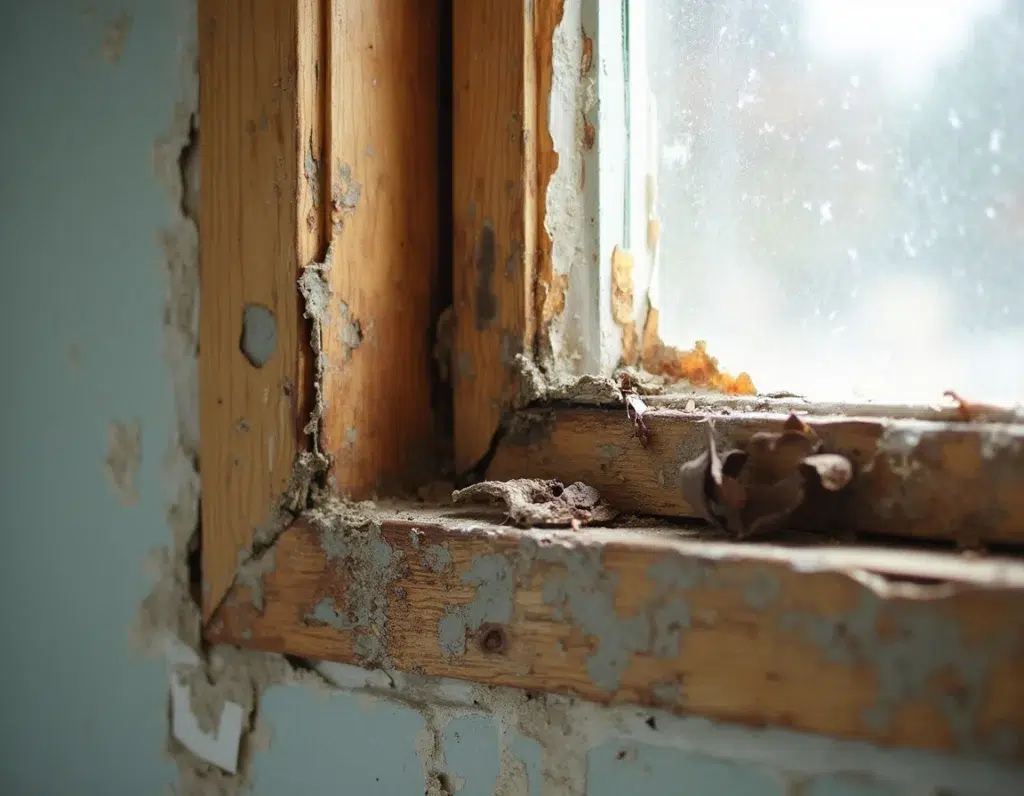
Water damage around windows is often a sign of leaks or poor sealing. As mentioned, leaks can lead to mold growth, rot in the window frames, and damage to the surrounding walls and floors, which are all costly to repair.
Impact: Water damage can lead to significant repair costs, especially if mold spreads or the structural integrity of your home is compromised. But even worse, it creates an unhealthy living environment, particularly if you have allergies or respiratory issues.
Prevention: Inspect the area around your windows for signs of water damage, such as discoloration, peeling paint, or soft spots in the walls. Address any leaks immediately by resealing the window or repairing damaged areas.
10. Drafty Windows
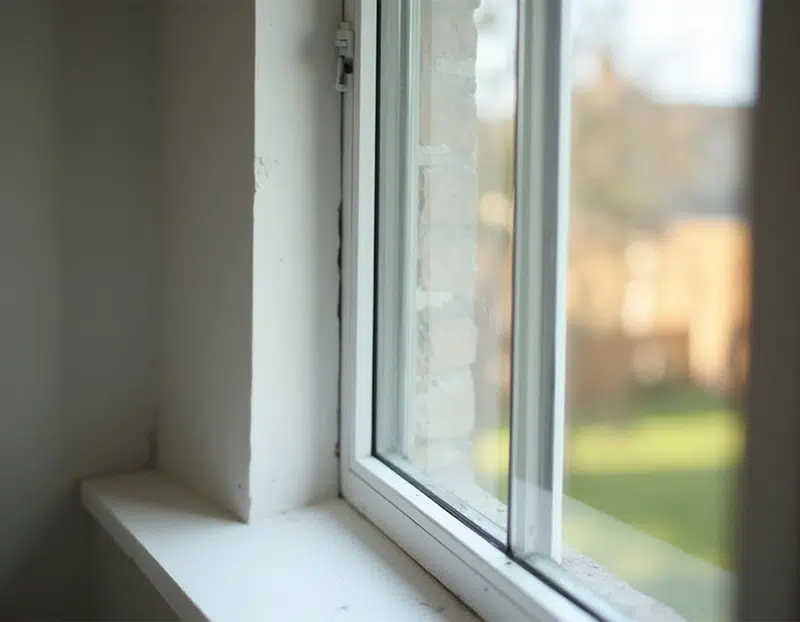
Drafty windows are often a result of poor seals or gaps in the window frame. This problem is a symptom of a different common problem. If you feel outside air coming into your house, you have drafty windows.
Impact: Drafts can increase your energy bills and make your home less comfortable. They can also indicate underlying issues with the window’s sealing or installation.
Prevention: To prevent drafts, check the seals around your windows periodically and replace them if they are worn or damaged. Adding weatherstripping can help to reduce drafts and improve your home’s energy efficiency.
Seasonal Window Problems and How to Address Them
Window problems can vary depending on the season, and knowing how to handle them can help keep your home comfortable throughout the year.
Winter
| Problem | Solution |
| Condensation | Improve insulation with film or curtains. |
| Freezing around seals | Inspect and repair window seals. |
| Moisture buildup | Increase ventilation and use a dehumidifier. |
Problem: Cold weather can cause condensation and freezing around windows and doors, leading to moisture buildup and possibly mold. These issues are common in winter due to the difference between warm indoor air and cold outdoor temperatures.
How to Address It:
- Improve Insulation: Consider using insulating film or thermal curtains to reduce heat loss and minimize condensation. Adding weatherstripping around the window frames can help block drafts.
- Increase Ventilation: Keeping the air in your home moving can lower humidity levels, which reduces condensation. A dehumidifier can help, especially in rooms where moisture tends to accumulate.
- Inspect Seals: Routinely check window seals and repair any gaps or cracks. If you see ice forming on the inside of your windows, it may indicate that the seals need to be replaced.
Summer
| Problem | Solution |
| Frame expansion | Seal gaps with weatherstripping or caulking. |
| Excess heat | Use shades, blinds, or reflective window films. |
| Air escape | Regular maintenance of window frames. |
Problem: Heat can cause window frames, especially wood windows, to expand, creating gaps that let air escape. This can make it harder to keep your home cool.
How to Address It:
- Seal Gaps: Check your window frames for any gaps caused by expansion and seal them with weatherstripping or caulking to keep the cool air inside.
- Use Shades: Consider using blinds, shades, or reflective window films to block out excess heat from the sun. This can help your air conditioning work more efficiently.
- Regular Maintenance: Keep your window frames in good condition by painting or sealing them. For wooden frames, a protective sealant can reduce the effects of humidity and temperature changes.
Preventative Measures for Window Care
As mentioned, regular maintenance is key to keeping your windows in good shape and avoiding costly repairs.
| Step | Action |
| Inspect Often | Regularly check for cracks, damaged seals, or warping. |
| Timely Repairs | Fix broken panes or issues immediately to avoid bigger problems. |
| Cleaning & Maintenance | Clean tracks and hinges; lubricate for smooth operation. |
| Seal Gaps | Apply weatherstripping or caulking to prevent drafts. |
More details on each:
- Inspect Often: Make it a habit to check your windows for any signs of trouble, like cracks, damaged seals, or warping. Catching these early can save you from bigger problems down the road.
- Timely Repairs: If you notice a broken pane or any other issue, fix it right away. Delaying repairs can lead to more extensive damage and higher costs later on.
- Cleaning and Maintenance: Keep your window tracks and hinges free of dirt and debris. A little cleaning and some lubrication can make sure your windows open and close smoothly.
- Seal Gaps: Look for any gaps around your window frames, especially after changes in temperature. Apply weatherstripping or caulking to seal these gaps and prevent drafts and moisture from getting in.
By staying on top of these simple tasks, you can extend the life of your windows and keep your home comfortable throughout the year.
Call a Professional for Repairs or Window Replacement
While some minor window repairs can be handled on your own, certain issues require professional expertise. If you’re experiencing any of the problems listed above, it’s best to consult with a professional window installer.
For expert advice and quality service, reach out to Allan at Better Window and Door for a free estimate. Addressing your window issues now can save you from more significant problems and expenses later.


